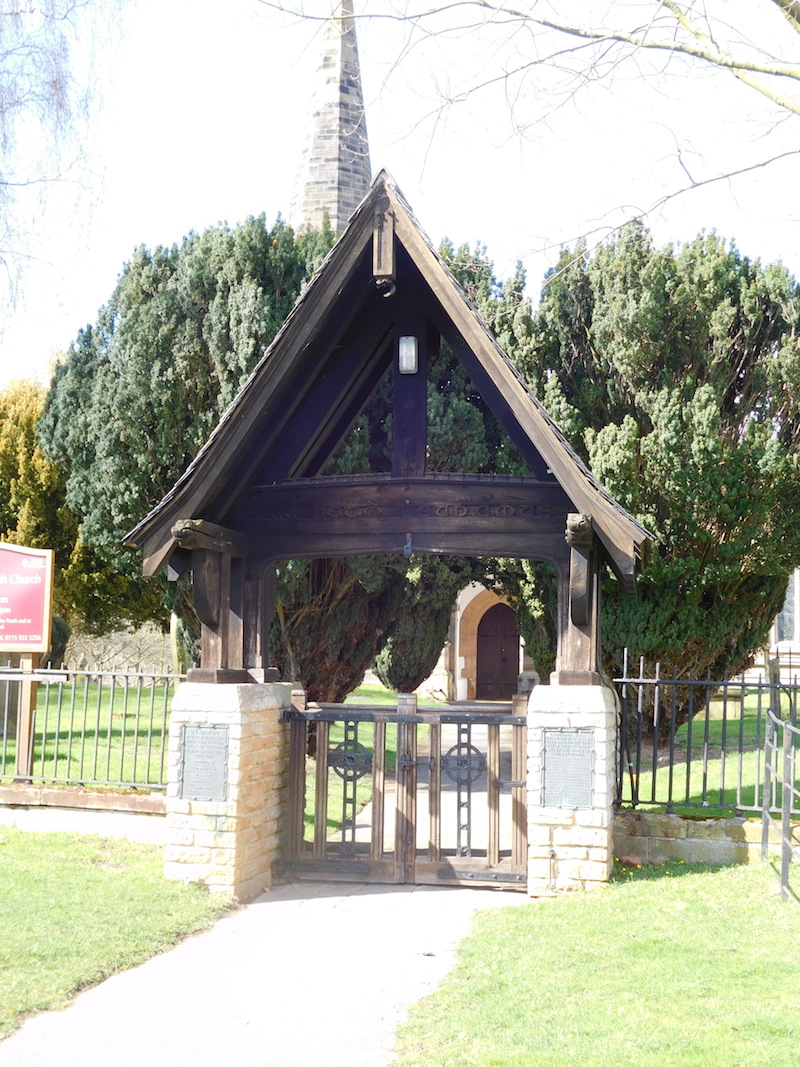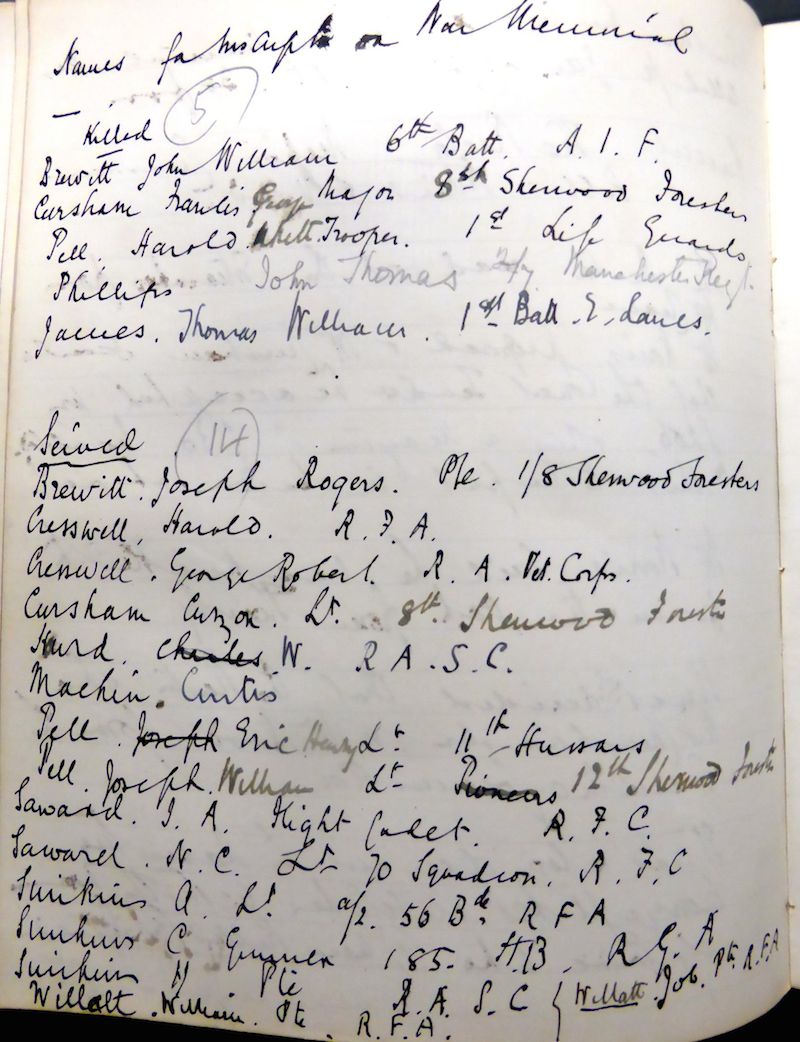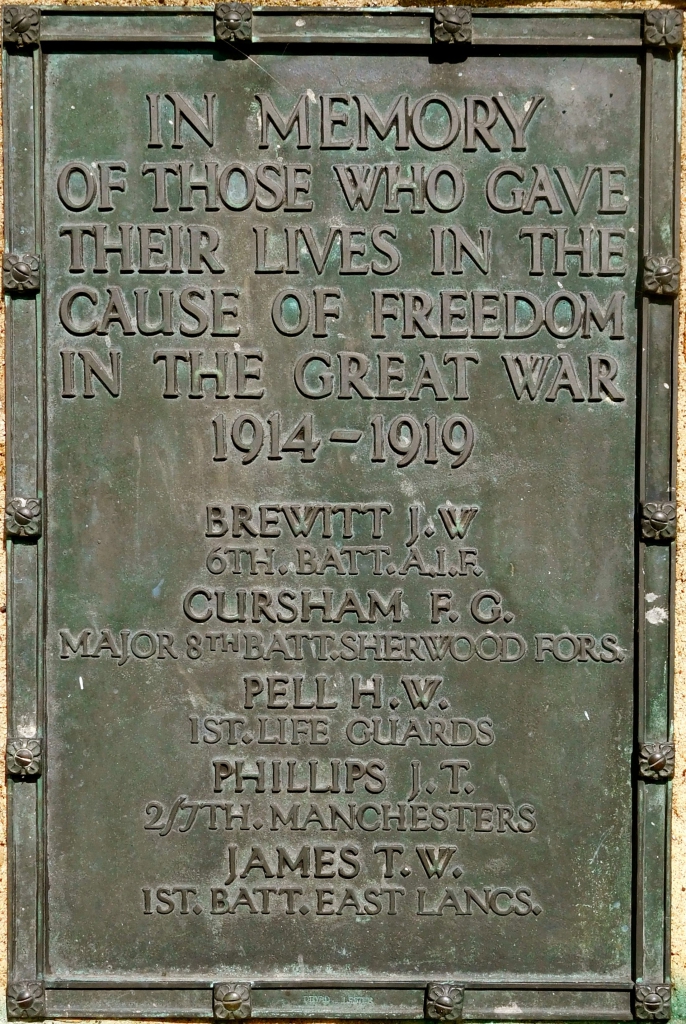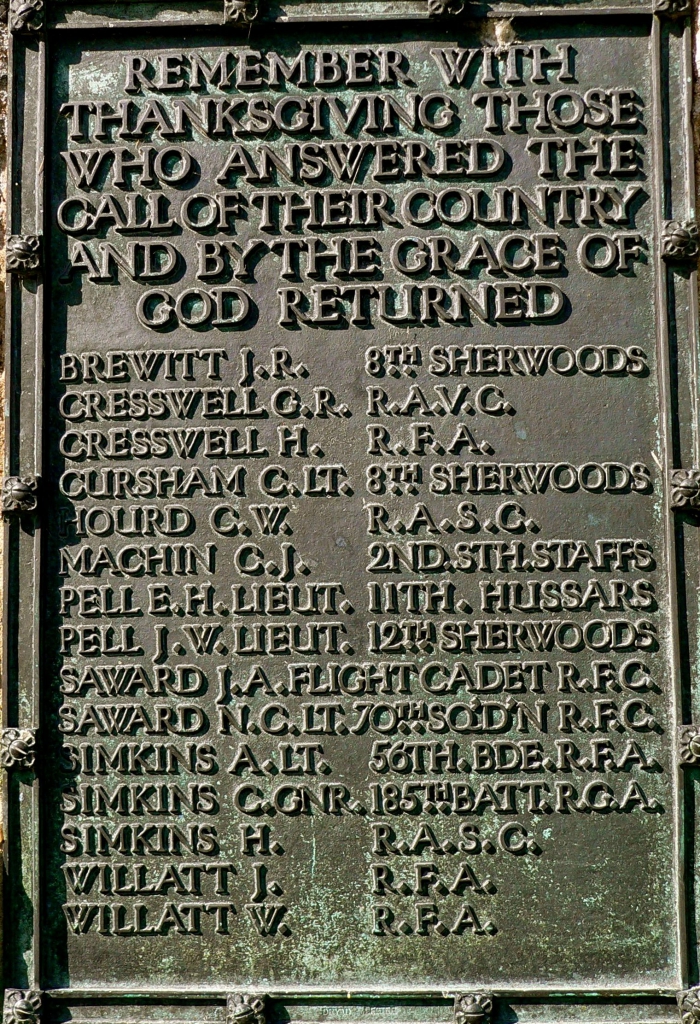Holme Pierrepont WWI Memorial
St Edmund’s Church Lychgate

Holme Pierrepont WWI Memorial Lychgate
Biographies of Home Pierrepont servicemen
Holme Pierrepont WWI memorial is a lychgate commemorating all the men from the parish who served in the First World War. The memorial is unusual. Unlike many, it does not take the form of a sacrificial cross standing in an elevated position. Instead, it is a simple wooden lychgate in the wall of St Edmund’s church. The inclusion of the names of those who returned, as well as those who died, recognises and remembers the contribution of all servicemen.
Holme Pierrepont was and remains a small community. At the time of the war, its population of just over two hundred was loosely divided between middle class families, whose heads were variously clergy, lawyers and farmers, and working class families who were mainly tenants employed on Earl Manvers estate. Minutes from the vestry and war memorial committee show that decisions about a war memorial were largely in the hands of the more affluent members of the community. Evidence has not yet been found of any public meetings to discuss the provision of a memorial.
Choosing a Memorial
The parish minutes of a meeting held on Easter Monday, April 20th, 1919 reveal an interesting discussion about who should be on the memorial and the form it should take. Five people present made suggestions about what would be appropriate. They were the rector, Rev. W.J. Saward, whose son Norman had been a prisoner of war, Mr. and Mrs. Cursham, whose son Major Francis Cursham was killed in a road accident, Mr. Pell, whose son Harold was killed on the Somme and Mr. Ireland, the lodge keeper on the estate. The minutes state:
During the meeting the Rector mentioned that he had sent a list of names to the Bishop and also to the Patron of those who had rendered loyal and faithful service to their church during the long and painful period of the war: Mr H. A. Cursham and Mr W. H. Pell, Church Wardens, Mr and Mrs Albert Rushton, George Wheatley, Mesdames Johnson, Bird and Holland.
The vestry then proceeded to a discussion of a war memorial for the parish. Several suggestions were made and ultimately Mr. Cursham’s scheme was adopted, Mr. Cursham intimating that he proposed to give £100 towards this. The scheme provides for the Sanctuary to be panelled in oak. The rector to obtain specification and estimate.
The original plan for an oak panelled memorial inside St Edmund’s Church was changed the following year. Minutes of a meeting held in November 1920 show the ‘war memorial committee’, which included most of the people at the vestry meeting, was now considering three proposals: oak panelling, a lychgate and a stone cross:
A Special Meeting of the War Memorial Committee was held on November 30th 1920. Present: The Rector, Mr and Mrs Cursham, Pell, Norris, and Mrs Elnor. The question before the meeting was to decide upon the form of the War Memorial for the parish. There were three main suggestions put forward
- Oak panelling for the East End
- A Lychgate
- A stone cross in the yard.
It was finally decided to have a Lychgate. Mr Norris (the land agent for Holme Pierrepont Estate) supported this and promised that Lord Manvers would provide the oak from Thoresby. The Rector was instructing the work to Mr Elnor (a local farmer) for an estimate. The fact that the minutes include the phrase ‘finally decided’ suggests there was much discussion about the form of the memorial and the decision about having a lychgate was not a foregone conclusion. Having made the decision, Mr. Norris as land agent would have been in a good position to acquire the timber from Thoresby Hall, Nottinghamshire, seat of the Pierrepont family. A list of potential subscribers for funding the memorial was drawn up by the committee and intentions were expressed about having a public appeal
Subscribers
The war memorial committee met again on Friday February 11th, 1921 and the meeting was attended by the rector, Mr. Cursham and Mr. Pell. The provisional list of names for the memorial was gone through and it was decided to make another appeal for ‘relatives and connections’ and to affix the list in the church porch as part of this process. Mr Pell then produced a list of subscriptions and the Rector made a note to draft a letter to sixteen people who, presumably, had an interest in the memorial. Some of the names in the minutes are illegible but the following names are discernible: Philip Challands, James, Kiddier, W. Machin, W. Saward, W. Sheldon, Mrs. Abel Smith, Wilding and H. Wilks. A further meeting took place on February 25th. A letter from Mr. Wood enclosing a list of subscriptions that had already been collected was given to the treasurer and the Rector read out the letter of appeal he had written for more money.
Names on the memorial
Many WWI memorials commemorate only those who lost their lives and often do not include details of rank and military unit. Radcliffe on Trent’s memorial, for instance, lists those who died and, in line with the common practice of giving equality to all in death, does not provide military details. It is evident that the Holme Pierrepont war memorial committee wanted to commemorate all who served. The decision may have been influenced by the fact that three of those on the committee had surviving as well as deceased sons who had seen action. The committee drew up a list of the men to be cited beginning with those who were killed and continuing with those who lived. The original list (below) indicates that including the rank and military unit of each man was part of the plan for the eventual presentation of the names. Pencilled-in notes suggest there was hesitation over some names. John Phillips’s first names, for instance, appear to be added later as are the Pells’ middle names. It is unclear whether Job Willatt was added at the meeting or later on. Sadly Charles Hourd, who is noted as ‘lived’ in the minutes and on the memorial, was to die in 1922 having been discharged in 1917 as no longer medically fit for service.

Twenty men’s names were identified by the committee. Two servicemen who survived do not appear on the list although we have included them in the Holme Pierrepont biographies. The first omission is Lt.Robert Challands. He married Frances Cursham, sister of Francis Cursham who was killed in an accident in 1918. Challands attended his brother-in-law’s military funeral at Holme Pierrepont. He also gave the village, where his parents were now living, as his address on the absent voter roll. Despite the Cursham family connection, and his parents’ residency, he was not considered eligible for the memorial by the committee. The other omission is Sgt. Charles Ellison M.M. who survived and was an absent voter listed in the 1918 Electoral Register. There are also no women on the memorial; it was common practice to commemorate men only. Mrs Elnor, who was on the committee, had four daughters and no sons. Her daughter Olive worked as a Red Cross nurse from January 1915 to February 1919 but her war service is disregarded on the memorial.
The biographies of the men on each plaque suggest the war had a devastating impact on many of them. Two were prisoners of war and one of them died in a prisoner of war camp in Germany. Three returned with wounds that were severe enough to prevent them from taking up their pre-war occupations; one of them died not long after the war. Another man came back with ‘shell shock’. Harold Pell was reported missing in action on the Somme. Letters from the private collection of the Pell family indicate the anguish they went through not knowing where their son was buried. His grave remains unidentified and he is remembered on the Thiepval Memorial to the Missing.
Words and inscriptions
The minutes do not show why particular phrases were chosen for the inscriptions on the memorial plaques. The vestry and war committee was mainly made up of professional men confident with words and this may account for their choice. The inscription chosen for those who died was In memory of those who gave their lives in the cause of freedom, 1914-1919. A pragmatic reason is thus given for their deaths, linking them to ideals of democracy.

In contrast, Radcliffe on Trent’s memorial refers simply to ‘gallant men’ and includes the more commonly used line from Ecclesiasticus ‘their names liveth for ever more’. The inscription for those who returned to Holme Pierrepont reads Remembering with thanksgiving those who answered the call of their country and by the grace of God returned. Here, patriotism is intertwined with protestant notions of God as an abiding presence and underlying source of order.

The overall message conveyed by the memorial plaques is that patriotic men from Holme Pierrepont fought for the continuation of principles underlying Britain’s political and cultural structure.
Contractors
The contractors chosen were:
Lewis and Grundy Hardware
Dryad Metal Works (see below)
Appleby – builders and joiners
McArthur
Dryad Metal Works is the probable designer of the memorial plaques and iron double gate. Harry Hardy Peach (1874–1936), the owner of thecompany, was a businessman in Leicester who campaigned for improved conditions in factories, the establishment of the Design and Industries Association and the Council for the Preservation of Rural England. After setting up Dryad Furniture, he established Dryad Metal Works in 1912 to supply architectural and household fittings manufactured in copper, brass and wrought iron. Many items produced were in the Arts and Crafts style. During World War I, Peach promoted craft work as a form of occupational therapy for wounded and disabled servicemen and then set up Dryad Handicrafts to meet the growing demand for craft materials (source: Wikipedia). Dryad Metal Works’ involvement in the memorial design is suggested not only by their name on the list of contractors but also by the metal work which blends stylistic elements from Arts and Crafts with those from the Art Nouveau movement.
Work on the proposed lychgate was completed by 1921. A date for the unveiling has not yet been established but progress on the memorial was reported at the annual parish meeting held in April 1921 together with a record of the money paid to contractors up to that point, amounting to £212. 16s. 7d.
Memorial structure
The memorial comprises a pair of rock-face ashlar walls at right angles to a wood and iron double gate. The bronze memorial plaques are set in the brickwork. The left plaque commemorates in embossed lettering those who died and the right plaque those who returned. The walls are topped with an open wooden framework supporting the gabled slate roof. The lychgate was given a Grade II listing in 1986.
The memorial stands on the boundary between the consecrated area of the church and the secular space of the fields that shape Holme Pierrepont’s landscape. The simplicity of the design and low position of the plaques make it easily accessible to the passer by and those entering or leaving the church. Despite its vicinity to Holme Pierrepont Hall, with its aristocratic lineage, the design of the memorial evokes ordinary lives transformed by the terrible carnage of World War I.
Read the biographies of Holme Pierrepont servicemen
Author: Rosemary Collins
